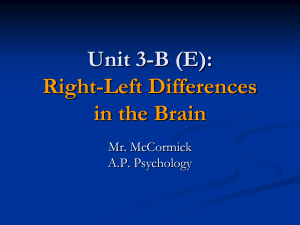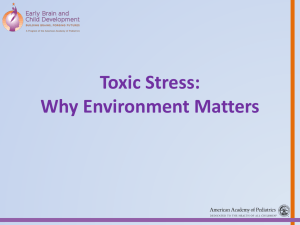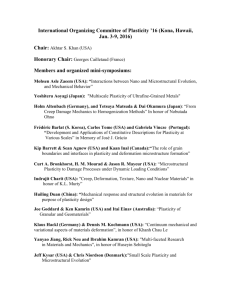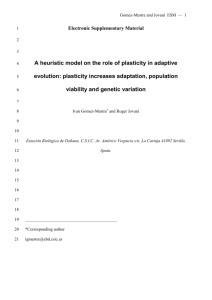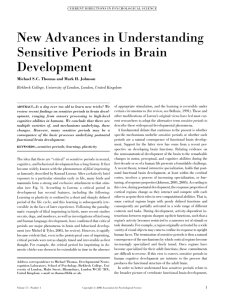DQ handout
advertisement
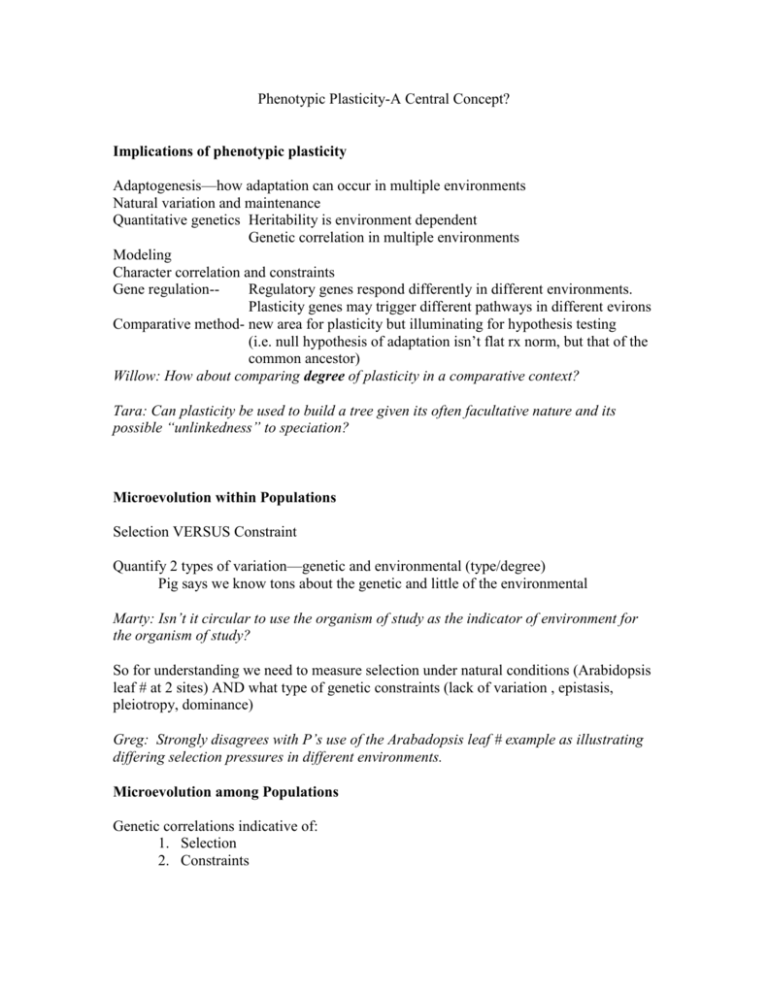
Phenotypic Plasticity-A Central Concept? Implications of phenotypic plasticity Adaptogenesis—how adaptation can occur in multiple environments Natural variation and maintenance Quantitative genetics Heritability is environment dependent Genetic correlation in multiple environments Modeling Character correlation and constraints Gene regulation-Regulatory genes respond differently in different environments. Plasticity genes may trigger different pathways in different evirons Comparative method- new area for plasticity but illuminating for hypothesis testing (i.e. null hypothesis of adaptation isn’t flat rx norm, but that of the common ancestor) Willow: How about comparing degree of plasticity in a comparative context? Tara: Can plasticity be used to build a tree given its often facultative nature and its possible “unlinkedness” to speciation? Microevolution within Populations Selection VERSUS Constraint Quantify 2 types of variation—genetic and environmental (type/degree) Pig says we know tons about the genetic and little of the environmental Marty: Isn’t it circular to use the organism of study as the indicator of environment for the organism of study? So for understanding we need to measure selection under natural conditions (Arabidopsis leaf # at 2 sites) AND what type of genetic constraints (lack of variation , epistasis, pleiotropy, dominance) Greg: Strongly disagrees with P’s use of the Arabadopsis leaf # example as illustrating differing selection pressures in different environments. Microevolution among Populations Genetic correlations indicative of: 1. Selection 2. Constraints What plasticity adds to the debate-- Considerations of constraints affecting same trait in different environments Constraints being plastic (not much of a constraint then, huh) Arabidopsis bolting example Jon: I hate figure 11.2. How can constraints be plastic? Four approaches to study constraints on plasticity 1. induce mutations and look for mutants that lie outside correlation line. 2. characterize pleiotropic and epistatic effects 3. select on one trait and then look for correlated effect on others (mechanistically linked?) 4. comparative method—when dealing w/ correlated characters can tell what was selected first Greg: How about using genetic correlations at the level of the family? This would free you from the model organism. West-Eberhard Interlude Steps to plasticity to result in speciation: 1. phenotype fixation 2. increased divergence due to above 3. acceleration of reproductive isolation due to above 4. rapid attainment of compatibility in sympatry Willow: Regarding #1 What constitutes phenotypic fixation? If you never see more than one environment can you tell if a phenotype is fixed? [See related Greg question below] Jon: Regarding #1…is evolution slower for more plastic organisms. Does speed of evolution=effectiveness of selection? How does evolutionary novelty (pg 264) fit into this? WWPS? Ted: Regarding #1…how do multiple phenotypes compete for the support of the rest of the genome? Evidence that polyphenism contributes to speciation: 1. a monophenic derived from an ancestral polyphenic population 2. the polyphenic population of origin had its phenotypes regulated by a switch 3. phenotype fixation occurred prior to or with reproductive isolation (was not an effect of isolation) 4. accentuated divergence after fixation Amber: Are all 4 types of evidence necessary, or is there some subset that is sufficient? Amber: What constitutes acceptable evidence for 3 & 4? Ted: Regarding pitcher plant mosquito…could paedomorphosis be a fexation of a metamorphic polymorphism? Greg: Butterfly example…Has any divergence taken place here since P. virginiensis still have the ability to suppress diapause and develop similarly to P. napi? I challenge that virginiensis has become fixed! Tara: Aphid example…does the host switch she describes really constitute an evolutionary step? Justin: Can you split a population of species based only on plasticity differences? How would this fit into to a species concept? Marty: How realistic is it that facultative expression of a trait can allow an environment/niche switch without hitting the “valley”? Ted: Do we have to invoke plasticity to explain species swarms? Macroevolution above the Species Level Shade avoidance phylogeny example—different shade avoidance traits in Arabidopsis show similar phylogenetic patterns. WHY? 1. genetic constraints imposed by regulatory gene(s) for these multiple traits 2. convergent evolution since lots of “space” for evolution to work traits that require multiple steps in production Macroevolution at Large Scales—Where does plasticity come from? Justin: What is the relationship between the evolution of a trait and its plasticity? Can the trait and the plasticity of that trait arise together or must a stable trait evolve plasticity? Look for answers with 1. molecular genetics via probing for homologous sequences 2. comparative method Example: Where does shade avoidance come from? 1. probing for homologous DNA led to similar stretches in green algae….so its old and may not have originally been for photoreceptors (exaptation) 2. functions do not match phylogeny (don’t know what that tells us) If time permits…worship Richard Goldschmidt.


